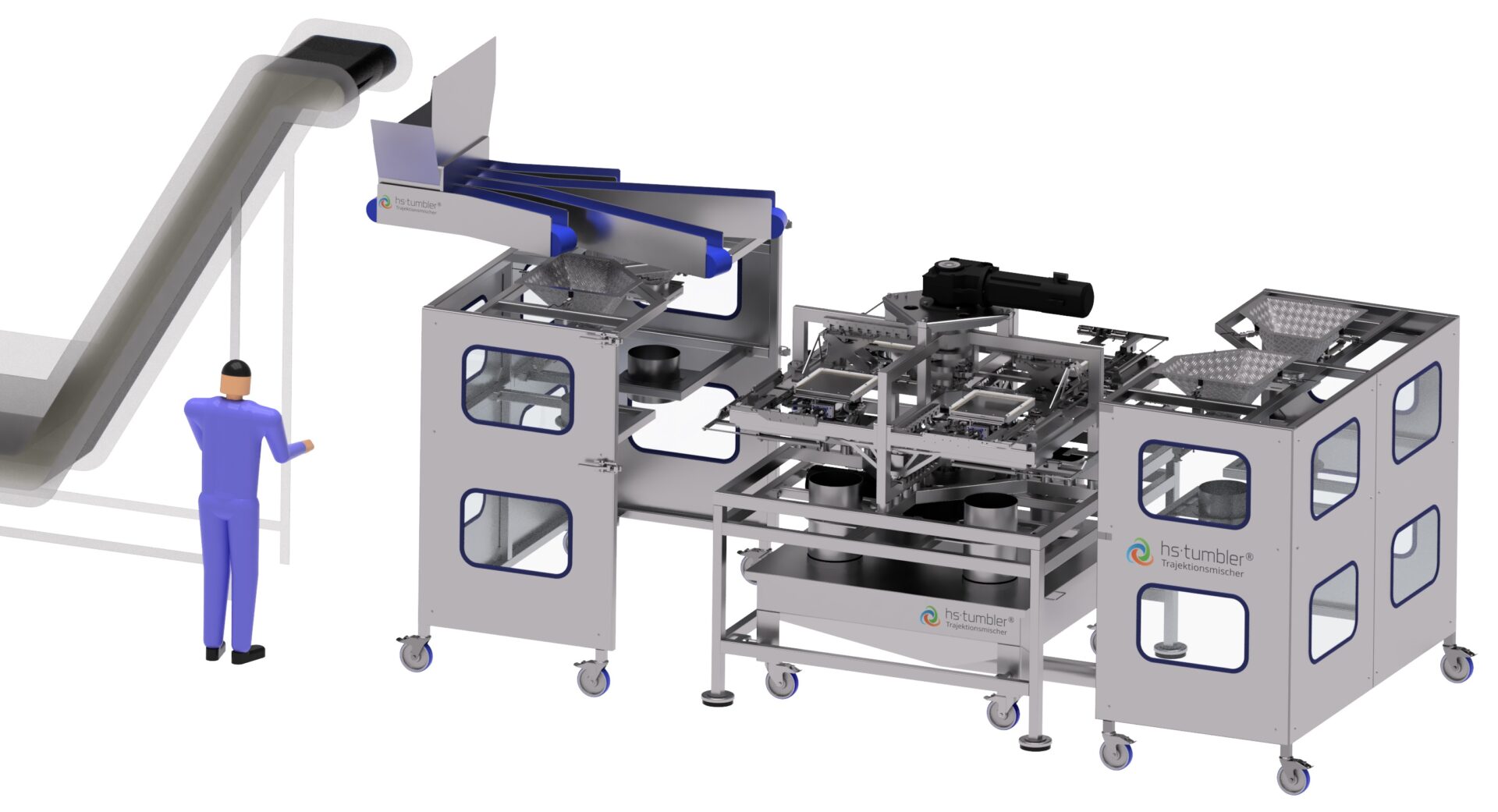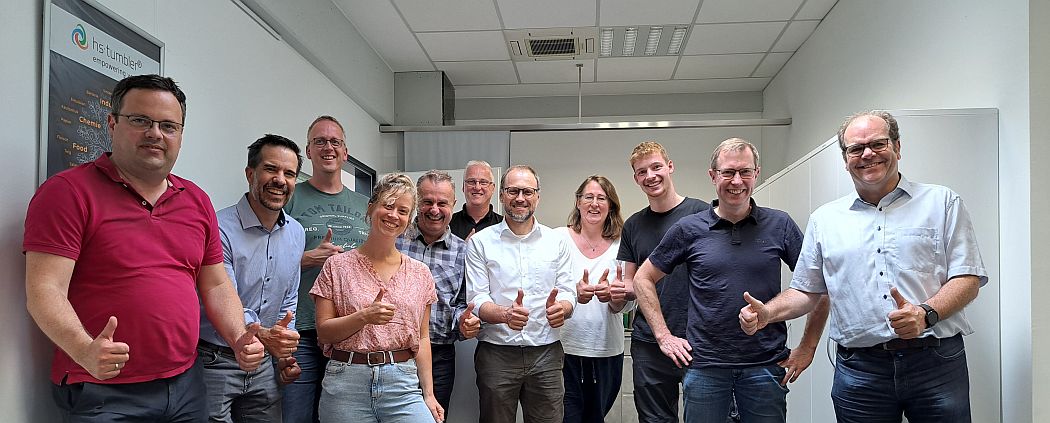“It sounds so simple,” says Bernhard Hukelmann, managing partner at German startup hs-tumbler. “And in theory at least, it is. We’re mixing without stirring with a stick.”
Selected by snacks and confectionery giant Mondelēz International for its 2024 CoLab Tech accelerator program, hs-tumbler—founded by Hukelmann in 2021—is pioneering a technique called trajectory mixing, which can be applied to everything from cookie dough and marinating meat to materials used in dental fillings.
In a nutshell, trajectory mixing mixes materials through the high-frequency movement of containers along a two-dimensional curved path, effectively shaking instead of stirring the contents such that everything is mixed at once, at great speed, with a fraction of the energy.
The movements generate shear and tensile forces that achieve a homogeneous mix, while controlling the movement parameters—moving the container from side to side, in a figure of eight, in a circle etc—allows the mixing quality to be tailored precisely to the material in question, says Mondelēz VP R&D Ian Noble.
“These guys have looked at mixing and asked the question: could we do it in a fundamentally different way?” he tells AgFunderNews. “And they’ve come up with a solution that is just so disruptive. Let’s say you want to make biscuit dough. Typically, you have a big mixer and you mix all those ingredients together to produce the dough. That takes a lot of power, a lot of energy.
“They asked what would happen if you just put it all in the container and shook it? Yes, it requires energy, but then you start looking at mixing times and wow, it’s super quick, so the efficiency is there. Then the question is how do I scale it? And it’s not necessarily a case of just getting bigger.”
“These guys have looked at mixing and asked the question: could we do it in a fundamentally different way? And they’ve come up with a solution that is just so disruptive.” Ian Noble, VP R&D, Mondelēz International

Near-continuous production
While the containers in hs-tumbler’s patented, programmable systems are relatively small (between 4.5 to 17 and ultimately 50 liters depending on the model), the system is set up for near-continuous production, with an automated filling system such that users can achieve superior throughput over the same time period versus a traditional industrial-scale mixer, says Hukelmann.
“We have a fully automated system with sliding lids on the bottom and top of each container, so product drops out after processing and pre-portioned ingredients drop in the top, so product exchanges take seconds.”
In short, he says, the award-winning system is “bringing process times down from hours in some cases to seconds. And so with a batch continuous system, we have a machine with a footprint of two by two meters, that is able to produce more than 100 tons a day with four vessels. So if we look at the meat industry, we can process three times what the largest mixer available on the market can do [over the same time period] with 90% less energy consumption.”
He adds: “Since we mix by shear forces, the scale up is always the same. It’s no matter if we do that in a small container or in a very large container, as long as we maintain the amplitude, the acceleration, the result will be the same.”
Given that the vessels in hs-tumbler’s machines are small and do not contain mixing implements, they are also easy and cheap to clean, says hs-tumbler managing director Andreas Leitze, who notes that the tech has been tested on every kind of material from powders to highly viscous liquids to dough, to meats (for tenderizing).
“It requires education, training, and an openness to try something new’
According to Leitze, several of hs-tumbler’s small-scale machines are now in operation in commercial kitchens, universities and meat companies and companies making dental fillings. A larger model should be operational at a meat customer’s site by the end of the year.
As for the market reception, says Hukelmann, as with any new technology, potential customers are skeptical at first, but are often blown away when they see it in action.
“At a strategic level, there’s a huge interest as we’re talking about flexibility and having this large throughput with such a small footprint in such a short time with reduced energy costs,” he says. “Changeovers are also faster as cleaning is much easier. But if you talk to people in production there is always hesitation because the system is totally different to what they are used to working with, so it requires education, training, and an openness to try something new.
“So in a meat plant for example they are used to huge tumblers that might operate for many hours in a purely batch process. We’re shifting to ultra-fast micro batches.”

Meat: ‘The easiest entry point and quite a big and attractive market’
To date, hs-tumbler has been funded by an undisclosed external angel investor, says Hukelmann, who says the firm is “basically financed for a relatively fast break in about one and a half years.”
While the technology has extremely broad applications, hs-tumbler is initially focusing on meat (tumbling, mixing, marinating) as it’s “the easiest entry point and quite a big and attractive market,” says Hukelmann. “But being part of the Mondelēz CoLab Tech cohort is exciting as it gives us the opportunity to explore what our technology can do in terms of snacking, so we’ll look at things like cookie doughs, cracker doughs, and so on.”
Another potentially interesting aspect of the system is its ability to enable mass customization through the rapid production of micro batches of goods, he points out. “Each batch can be a different recipe, which is something we want to investigate with Mondelēz.”
Optimizing the trajectory
But how does hs-tumbler know what the best configuration will be for any given product? Should the vessels be moved back and forth? Rotated? Moved in a complex figure of eight?
“Once you work with this device, you develop a good gut feel of how best to process a certain type of product, whether you want a sharp curve with many shear forces or many long curves with fewer sheer forces,” says Hukelmann.
But testing is obviously required to validate this, adds Hukelmann, who notes that the pattern of movement may also change during the mixing process, which is programmable. “For example, with pizza dough, in the first stage, you want to have a good mixing, but then you need to change the shape for a good kneading curve. And finally, if you want to have a nice round ball of dough that drops out of the machine, you can use the circle curve.”
Longer-term, he says, hs-tumbler is training AI to optimize the process by listening to the sounds produced while processing, which provide a useful indicator of what is happening inside.
Ultimately, he says, “AI will create the [optimal] shape of the steering necessary for the product at any given stage [of the mixing process].”




